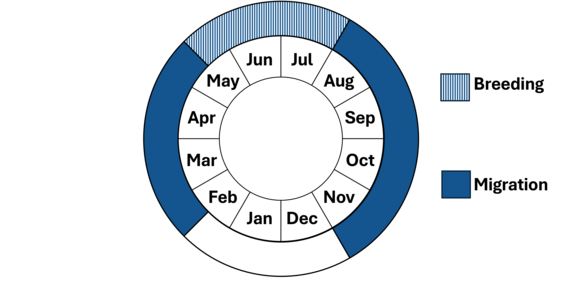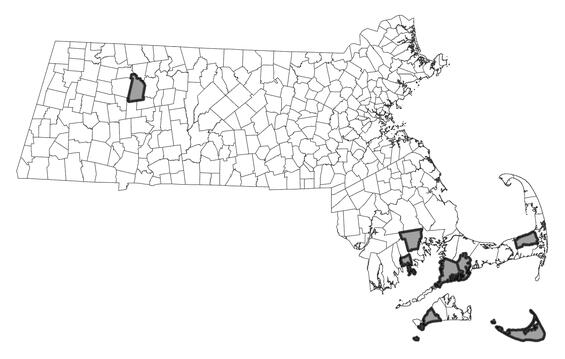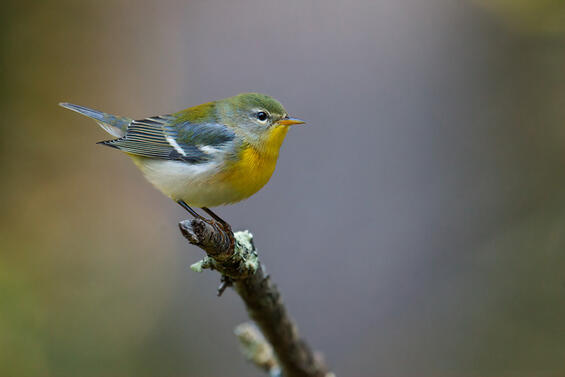- Scientific name: Setophaga americana
- Species of Greatest Conservation Need (MA State Wildlife Action Plan)
- Threatened (MA Endangered Species Act)
Description

Northern parula (Setophaga americana)
The northern parula is one of the smallest and most distinctly marked of the North American wood warblers. They are 10.8-12 cm (4.25-4.75 in) in length with a wing spread of 17.8-19.7 cm (7-7.75 in). The males are bright blue-grey above, white below, an olive patch on the upper back, and two bold white wing bars. They have a white eye ring broken by a black eye line and a bright yellow throat with a dusky, red-brown chest band. Females and juveniles are similar but paler and have little or no throat band. The male sings during the nesting season into late July and frequently during spring migration. It has at least three main songs, with a great range of variations. The most common is a buzzy, ascending trill, ending with an abrupt, explosive note: “swee swee swee swee swee-Zip!”
Life cycle and behavior

Phenology in Massachusetts. This is a simplification of the annual life cycle. Timing exhibited by individuals in a population varies, so adjacent life stages generally overlap each other at their starts and ends.
In the Northeast, the parula begins nesting in late May or early June. The nest is generally hidden inside a clump of hanging Usnea lichen in either a deciduous or conifer tree. Though predominantly made of Usnea spp., the nest may be sparsely lined with finely shredded moss, fine grasses, plant down, or a few hairs. Upon completion, the nest resembles a hanging grey pouch with an opening at or near the top. The nest may also be constructed of other material, such as burlap, leaf fragments, or grass, but this is exceptional. The height of the nest varies from 4 to 40 feet above ground with the average being 25 feet. The same nesting site is often occupied in successive seasons with eggs being laid in the same nest or in another nearby. The parula lays only one clutch of 4 to 5 eggs each year. The eggs are white to cream, speckled with brown and are incubated for 12 to 14 days. The young fledge 11 to 12 days after hatching.
Like others in its family, the parula feeds on a variety of small insects such as cankerworms, hairy tent caterpillars, gypsy moth caterpillars, beetles, and spiders. When feeding, it hops from twig to twig, inspecting leaves, often hanging upside down, much like a chickadee, or it may creep along trunks or branches like a nuthatch.
This species migrates south in September and October with other warblers. Parulas return to Massachusetts in the beginning of May, although it is more typically a migrant here than a summer resident.
Population status
The northern parula is an uncommon nester in Massachusetts. During the first Breeding Bird Atlas, parulas were only documented in 13 blocks and confirmed breeding was only in four blocks. The second Breeding Bird Atlas reported numerous detections of parulas in the western portion of the state, but none of those had confirmed nesting. Although parulas were detected in 28 blocks for the second Atlas, blocks with confirmed nesting remained at four. Nesting is limited in Massachusetts and coincides with the occurrence of its favored nesting material, Usnea, which may be sensitive to air pollution and acid rain. The Breeding Bird Survey reveals a range-wide 1.3% annual increase for the species between 1966-2022.
Distribution and abundance
The breeding range of the northern parula extends from Nova Scotia to Manitoba, south to central Florida and Texas. It is generally associated in the north with the lichen old-man’s beard (Usnea spp.) and in the south with Spanish moss (Tillandsia usneoides). It winters primarily in Mexico, northern Central America, and the West Indies.

Distribution in Massachusetts. 1999-2024. Based on records in the Natural Heritage Database.
Habitat
The parula is characteristically found in wet woodlands, such as red maple (Acer rubrum) or Atlantic white cedar (Chamaecyparis thyiodes) swamps, river margins, pond shores, or even small depressions. It usually nests in association with the moss-like lichen, old-man’s beard (Usnea spp.).
Healthy habitats are vital for supporting native wildlife and plants. Explore habitats and learn about conservation and restoration in Massachusetts.

Northern parula (Setophaga americana)
Threats
A threat to the parula in Massachusetts is the decline of the Usnea lichen that it uses for nesting. As with other migratory songbirds, another threat is collisions with artificial structures (e.g., buildings).
Predation by domestic cats has been identified as the largest source of mortality for wild birds in the United States with the number of estimated mortalities exceeding 2 billion annually. Cats are especially a threat to those species that nest on or near the ground.
An additional threat to the species is collisions with buildings and other structures, as approximately 1 billion birds in the United States are estimated to die annually from building collisions. A high percentage of these collisions occur during the migratory periods when birds fly long distances between their wintering and breeding grounds. Light pollution exacerbates this threat for nocturnal migrants as it can disrupt their navigational capabilities and lure them into urban areas, increasing the risk of collisions or exhaustion from circling lit structures or areas.
Conservation
Research on the nesting ecology, particularly with regard to the extent of the parula’s dependence upon Usnea, is needed to determine what role, if any, that relationship has impacted the species’ decline in the state. More information is needed on the parula’s wintering ecology and the effects of habitat loss and degradation on the wintering grounds.
Promote responsible pet ownership that supports wildlife and pet health by keeping cats indoors and encouraging others to follow guidelines found at fishwildlife.org.
Bird collision mortalities can be minimized by making glass more visible to birds. This includes using bird-safe glass in new construction and retrofitting existing glass (e.g., screens, window decals) to make it bird-friendly and reducing artificial lighting around buildings (e.g., Lights Out Programs, utilizing down shielding lights) that attract birds during their nocturnal migration.
References
Forbush, E.H. Birds of Massachusetts and Other New England States. Vol. III: Land Birds from Sparrows to Thrushes. Norwood, MA: Norwood Press/Berwick & Smith Company, 1927.
Moldenhauer, R. R. and D. J. Regelski (2020). Northern Parula (Setophaga americana), version 1.0. In Birds of the World (A. F. Poole, Editor). Cornell Lab of Ornithology, Ithaca, NY, USA.
Petersen, W.R., and R.R. Veit. Birds of Massachusetts. Lincoln, MA: Massachusetts Audubon Society, 1993.
Nikula, B. “Northern Parula.” 1986. Natural Heritage and Endangered Species Program. Boston, MA.
Robbins, C.S., B. Brunn, and H.S. Zim. Birds of North America. New York: Golden Press, 1983.
Sauer, J.R., J.E. Hines, J.E. Fallon, K.L. Pardieck, D.J. Ziolkowski, Jr., and W.A. Link. 2022. The North American Breeding Bird Survey, Results and Analysis 1966 – 2022. Laurel, MD.
Walsh, J. and W.R. Petersen. 2013. Massachusetts Breeding Bird Atlas 2. Massachusetts Audubon Society and Scott & Nix, Inc.
Contact
| Date published: | April 25, 2025 |
|---|